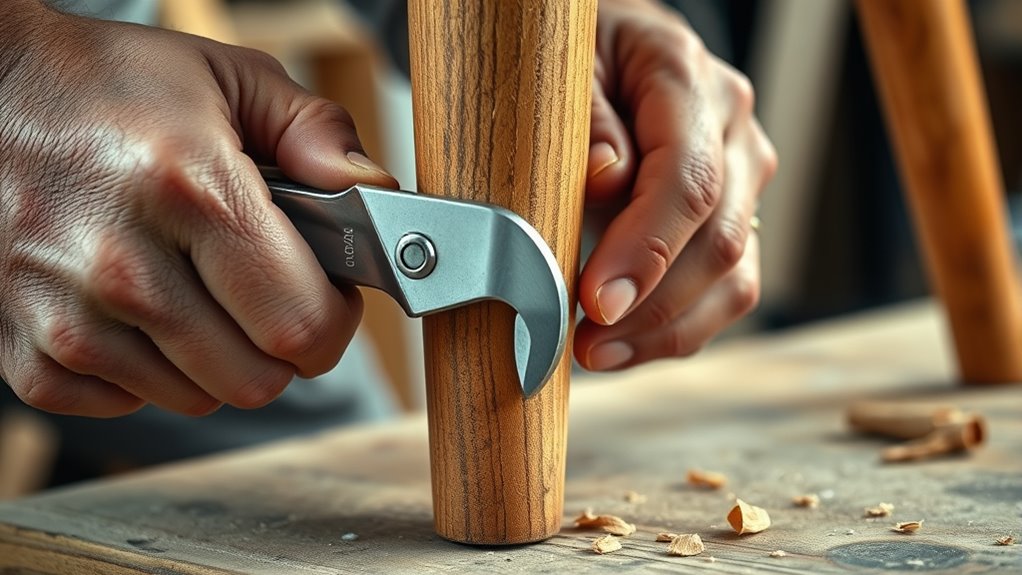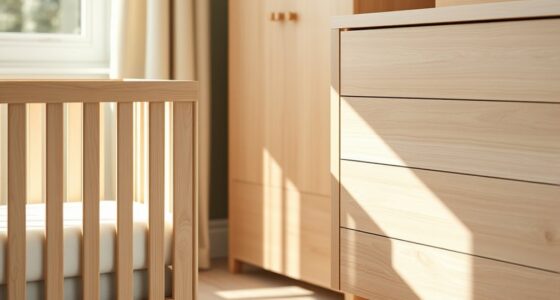To fix wobbly chairs and tables, start by inspecting all joints, legs, and fasteners. Tighten any loose screws or bolts with a screwdriver or wrench. If certain legs are broken or uneven, replace or add furniture pads or shims to level the surface. Reattach loose legs firmly, using wood glue or dowels if needed. For more tips on ensuring stability and safety, keep exploring further solutions to keep your furniture steady.
Key Takeaways
- Inspect and identify loose joints, screws, or damaged legs causing wobbliness.
- Tighten all visible screws, bolts, and fasteners using appropriate tools.
- Reinforce loose joints with wood glue or additional fasteners for stability.
- Level uneven furniture by adding pads or shims under shorter or uneven legs.
- Replace damaged or broken legs to ensure secure and balanced support.

A wobbly chair or table can be annoying and even unsafe, but fixing it is often simpler than you might think. When furniture becomes unstable, it’s tempting to replace it entirely, but with some basic tools and a bit of DIY repair, you can restore stability quickly and cost-effectively. Ensuring your furniture is secure not only improves its appearance but also keeps you safe during everyday use.
Start by inspecting your furniture closely. Look for loose or damaged joints, wobbly legs, or uneven surfaces. Most wobbliness comes from loose screws, bolts, or joints that need tightening. Grab a screwdriver or wrench, depending on the fasteners used, and tighten all visible screws and bolts. Often, this simple step alone can eliminate a lot of the wobbling. If certain joints are still loose after tightening, consider applying some wood glue or joint reinforcement to provide extra stability, especially in wooden furniture. These small adjustments are a key part of DIY repair for furniture stability.
Inspect and tighten loose screws and joints to quickly stabilize wobbly furniture.
Next, check the levelness of your furniture. Use a spirit level to identify uneven legs or surfaces. If one leg is shorter or uneven, you can fix this by adding a furniture pad or felt pad under the shorter leg to level it out. For more permanent solutions, you might need to replace or adjust the leg. If a leg is broken or cracked, replacing it is often the best option. For wood furniture, you can usually find replacement legs at hardware stores or online, and installing them is straightforward with the right tools.
Sometimes, wobbliness is caused by the furniture’s legs not being properly attached to the base. If that’s the case, remove the leg and reattach it using strong wood screws or bolts, along with wood glue for added support. Make sure to tighten everything firmly but avoid overtightening, which can cause damage. If the leg has become loose over time, consider using threaded inserts or dowels for a more durable fix. These DIY repair techniques can markedly improve your furniture’s stability and extend its lifespan.
Additionally, consider checking the safety of your furniture to ensure that it remains secure and reliable over time, especially if it is frequently used or subjected to heavy loads. Finally, double-check the overall balance of your piece. Even furniture with tight joints and attached legs can wobble if it’s sitting on an uneven surface. Move your furniture to a flat, level spot, or adjust the placement of pads and shims underneath to stabilize it. Small adjustments like these can make a big difference in furniture stability. With a little effort, your furniture will be sturdy, safe, and ready for everyday use, all without the need for costly replacements.
Frequently Asked Questions
Can I Fix Wobbly Furniture Without Tools?
Yes, you can improve furniture stability without tools by trying simple DIY solutions. Use household items like rubber bands, felt pads, or even wax to fill gaps or provide extra grip. You might also add weight to the furniture’s base or place non-slip pads underneath. These quick fixes help stabilize wobbly furniture, making it safer and more secure without needing any specialized tools.
How Often Should I Tighten Chair or Table Joints?
You should tighten chair or table joints every few months to maintain joint reinforcement and guarantee furniture stability. Think of it as regular upkeep for peace of mind—just like changing oil keeps a car running smoothly. If you notice wobbling or looseness, tighten immediately. Regular checks prevent bigger problems, so make it a habit. This way, your furniture stays sturdy and safe, and you avoid costly repairs down the line.
Are There Specific Types of Glue for Loose Joints?
Yes, there are specific types of glue for loose joints. You should use wood glue, which is designed for bonding wood surfaces effectively. For extra strength, consider epoxy adhesive, especially on heavier or more stressed joints. Both types create durable bonds, but epoxy dries harder and fills gaps better. Follow the manufacturer’s instructions for application and clamping to guarantee a tight, lasting repair.
Is It Safe to Use Power Tools for Tightening?
Yes, it’s safe to use power tools for tightening, but you should prioritize power tool safety. Always wear protective gear, guarantee the tool is in good condition, and follow the manufacturer’s instructions. Use the right bit or attachment for your DIY repair tips, and go slowly to avoid stripping screws or damaging the wood. Proper handling minimizes risks, making your repair efficient and safe.
Can Regular Maintenance Prevent Wobbliness?
A stitch in time saves nine, and the same goes for furniture stability. Regular maintenance keeps your chairs and tables in good shape, preventing wobbles before they start. By following a consistent maintenance schedule, you catch loose joints or screws early, saving you from bigger repairs later. So yes, regular upkeep truly can prevent wobbliness, ensuring your furniture stays sturdy and safe for everyday use.
Conclusion
Now that you’ve tightened those wobbly chairs and tables, they’ll stand taller and prouder than a mountain peak! No more wobbling like a leaf in the wind—your furniture will be as steady as a fortress. Imagine hosting dinner parties where your guests don’t feel like they’re on a roller coaster. With just a few simple fixes, your furniture transforms into the rock-solid champions of your home, ready to withstand even the wildest gatherings!









